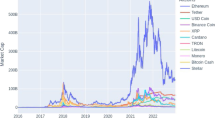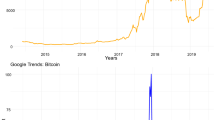Abstract
Forecasting Bitcoin’s returns continues to be a challenging endeavor for both scholars and practitioners. In this paper, we train a random forest model on a variety of features, with the aim of predicting pronounced changes in the returns of Bitcoin. The model that we present in this paper outperforms the baseline model with which we compare it: the LPPL model. Our results have implications for scholars studying financial prediction models, as well as for practitioners interested in Bitcoin investment.

Similar content being viewed by others
Data availability
The data sets used for the analysis can be openly downloaded under this DOI: https://doi.org/10.17632/w2s5rf58zd.1.
References
Albrecht, S., Lutz, B., & Neumann, D. (2019). How sentiment impacts the success of blockchain startups—An analysis of social media data and initial coin offerings. In Proceedings of the 52nd Hawaii International Conference on System Sciences 2019, Hawaii, pp. 4545–4556.
Antweiler, W., & Frank, M. Z. (2004). Is all that talk just noise? The information content of internet stock message boards. The Journal of Finance, 59(3), 1259–1294.
Ball, R., Gerakos, J., Linnainmaa, J. T., & Nikolaev, V. (2016). Accruals, cash flows, and operating profitability in the cross section of stock returns. Journal of Financial Economics, 121(1), 28–45.
Barrau, T., & Douady, R. (2022). Predictions of market returns. Artificial intelligence for financial markets (pp. 59–81). Springer.
Bing, L., Chan, K. C., & Ou, C. (2014). Public sentiment analysis in twitter data for prediction of a company’s stock price movements. In 2014 IEEE 11th International Conference on e-Business Engineering, pp. 232–239.
Bollen, J., Mao, H., & Zeng, X. (2011). Twitter mood predicts the stock market. Journal of Computational Science, 2(1), 1–8.
Chanson, M., Martens, N., & Wortmann, F. (2020). The role of user-generated content in blockchain-based decentralized finance. In Proceedings of the 28th European Conference on Information Systems (online).
Chowdhury, R., Rahman, M. A., Rahman, M. S., & Mahdy, M. (2020). An approach to predict and forecast the price of constituents and index of cryptocurrency using machine learning. Physica A: Statistical Mechanics and its Applications, 551, 124569.
Clemons, E. K., & Thatcher, M. E. (1997). Evaluating alternative information regiines in the private health insurance industry: Managing the social cost of private information. Journal of Management Information Systems, 14(2), 9–31.
Das, S. R., & Chen, M. Y. (2007). Yahoo! for amazon: Sentiment extraction from small talk on the web. Management Science, 53(9), 1375–1388.
Domingos, P. (2012). A few useful things to know about machine learning. Communications of the ACM, 55(10), 78–87.
Eisenhardt, K. M., & Bhatia, M. M. (2017). Organizational complexity and computation (pp. 442–466). The Blackwell Companion to Organizations.
Fama, E. F. (1970). Efficient capital markets: A review of theory and empirical work. The Journal of Finance, 25(2), 383–417.
Farmer, J. D., Gallegati, M., Hommes, C., Kirman, A., Ormerod, P., Cincotti, S., Sanchez, A., & Helbing, D. (2012). A complex systems approach to constructing better models for managing financial markets and the economy. The European Physical Journal Special Topics, 214(1), 295–324.
Feuerriegel, S., & Prendinger, H. (2016). News-based trading strategies. Decision Support Systems, 90, 65–74.
Geraskin, P., & Fantazzini, D. (2013). Everything you always wanted to know about log-periodic power laws for bubble modeling but were afraid to ask. The European Journal of Finance, 19(5), 366–391.
Geuder, J., Kinateder, H., & Wagner, N. F. (2019). Cryptocurrencies as financial bubbles: The case of bitcoin. Finance Research Letters, 31, 179–184.
Ghosh, B., Kenourgios, D., Francis, A., & Bhattacharyya, S. (2021). How well the log periodic power law works in an emerging stock market? Applied Economics Letters, 28(14), 1174–1180.
Grossman, S. J., & Stiglitz, J. E. (1980). On the impossibility of informationally efficient markets. The American Economic Review, 70(3), 393–408.
Gu, S., Kelly, B., & Xiu, D. (2020). Empirical asset pricing via machine learning. The Review of Financial Studies, 33(5), 2223–2273.
Hartmann, J., Heitmann, M., Siebert, C., & Schamp, C. (2022). More than a feeling: Accuracy and application of sentiment analysis. SSRN Electronic Journal, 1, 1. https://doi.org/10.2139/ssrn.3489963
Ho, C.-S., Damien, P., Gu, B., & Konana, P. (2017). The time-varying nature of social media sentiments in modeling stock returns. Decision Support Systems, 101, 69–81.
Keller, A., & Scholz, M. (2019). Trading on cryptocurrency markets: Analyzing the behavior of bitcoin investors. In Proceedings of the Fortieth International Conference on Information Systems, Munich.
Kraaijeveld, O., & De Smedt, J. (2020). The predictive power of public twitter sentiment for forecasting cryptocurrency prices. Journal of International Financial Markets, Institutions and Money, 65, 101188.
Li, T., van Dalen, J., & van Rees, P. J. (2018). More than just noise? Examining the information content of stock microblogs on financial markets. Journal of Information Technology, 33(1), 50–69.
Lopez-Padial, D., & Harris, C. (2018). Python technical analysis (tech. rep.). https://technical-analysis-library-in-python.readthedocs.io/en/latest/
Ma, Y., Han, R., & Wang, W. (2021). Portfolio optimization with return prediction using deep learning and machine learning. Expert Systems with Applications, 165, 113973.
Nagula, P. K., & Alexakis, C. (2022). A new hybrid machine learning model for predicting the bitcoin (BTC-USD) price. Journal of Behavioral and Experimental Finance, 36, 100741.
Oliveira, N., Cortez, P., & Areal, N. (2016). Stock market sentiment lexicon acquisition using microblogging data and statistical measures. Decision Support Systems, 85, 62–73.
Pant, D. R., Neupane, P., Poudel, A., Pokhrel, A. K., & Lama, B. K. (2018). Recurrent neural network based bitcoin price prediction by twitter sentiment analysis. In 2018 IEEE 3rd International Conference on Computing, Communication and Security (ICCCS), pp. 128–132.
Parra-Moyano, J., Partida, D., & Gessl, M. (2023). Your sentiment matters: A machine learning approach for predicting regime changes in the cryptocurrency market. In The 56th Hawaii International Conference on System Sciences, HICSS 2023, pp. 920–929.
Pedregosa, F., Varoquaux, G., Gramfort, A., Michel, V., Thirion, B., Grisel, O., Blondel, M., Prettenhofer, P., Weiss, R., Dubourg, V., et al. (2011). Scikit-learn: Machine learning in python. Journal of Machine Learning Research, 12, 2825–2830.
Ranco, G., Aleksovski, D., Caldarelli, G., Grčar, M., & Mozetič, I. (2015). The effects of twitter sentiment on stock price returns. PLoS One, 10(9), e0138441.
Rane, P. V., & Dhage, S. N. (2019). Systematic erudition of bitcoin price prediction using machine learning techniques. In 2019 5th International Conference on Advanced Computing and Communication Systems (ICACCS), 65(2), 594–598.
Rokach, L., & Maimon, O. (2005). Decision trees. Data mining and knowledge discovery handbook (pp. 165–192). Springer.
Sarlin, P., & Mezei, J. (2020). Introduction to the minitrack on machine learning and predictive analytics in accounting, finance and management.
Shu, M., Song, R., & Zhu, W. (2021). The 2021 bitcoin bubbles and crashes—detection and classification. Stats, 4(4), 950–970.
Sornette, D., Johansen, A., & Bouchaud, J.-P. (1996). Stock market crashes, precursors and replicas. Journal de Physique I, 6(1), 167–175.
Vieira, L. I., & Laurini, M. P. (2023). Time-varying higher moments in bitcoin. Digital Finance, 5, 231–260. https://doi.org/10.1007/s42521-022-00072-8
Wheatley, S., Sornette, D., Huber, T., Reppen, M., & Gantner, R. N. (2019). Are bitcoin bubbles predictable? combining a generalized Metcalfe’s law and the log-periodic power law singularity model. Royal Society Open Science, 6(6), 180538.
Wilksch, M. V., & Abramova, O. (2022). The predictive power of social media sentiment for short-term stock movements. In Proceedings of the 17th International Conference on Wirtschaftsinformatik, Nürnberg, pp. 1092–1100.
Wolk, K. (2020). Advanced social media sentiment analysis for short-term cryptocurrency price prediction. Expert Systems, 37(2), e12493.
Xia Liu, A., Li, Y., & Xu, S. X. (2021). Assessing the unacquainted: Inferred reviewer personality and review helpfulness. MIS Quarterly, 45(3), 14375.
Yousaf, I., & Ali, S. (2020). Discovering interlinkages between major cryptocurrencies using high-frequency data: New evidence from COVID-19 pandemic. Financial Innovation, 6(1), 1–18.
Zhang, W., & Ram, S. (2020). A comprehensive analysis of triggers and risk factors for asthma based on machine learning and large heterogeneous data sources. MIS Quarterly, 44(1), 305–349.
Acknowledgements
We are thankful to Dave Brooks from elcs.ch for excellent editorial support.
Author information
Authors and Affiliations
Contributions
All authors have contributed equally to the article.
Corresponding author
Ethics declarations
Conflict of interest
The authors declare no Conflict of interest.
Additional information
Publisher's Note
Springer Nature remains neutral with regard to jurisdictional claims in published maps and institutional affiliations.
Rights and permissions
Springer Nature or its licensor (e.g. a society or other partner) holds exclusive rights to this article under a publishing agreement with the author(s) or other rightsholder(s); author self-archiving of the accepted manuscript version of this article is solely governed by the terms of such publishing agreement and applicable law.
About this article
Cite this article
Parra-Moyano, J., Partida, D., Gessl, M. et al. Analyzing swings in Bitcoin returns: a comparative study of the LPPL and sentiment-informed random forest models. Digit Finance (2024). https://doi.org/10.1007/s42521-024-00110-7
Received:
Accepted:
Published:
DOI: https://doi.org/10.1007/s42521-024-00110-7




